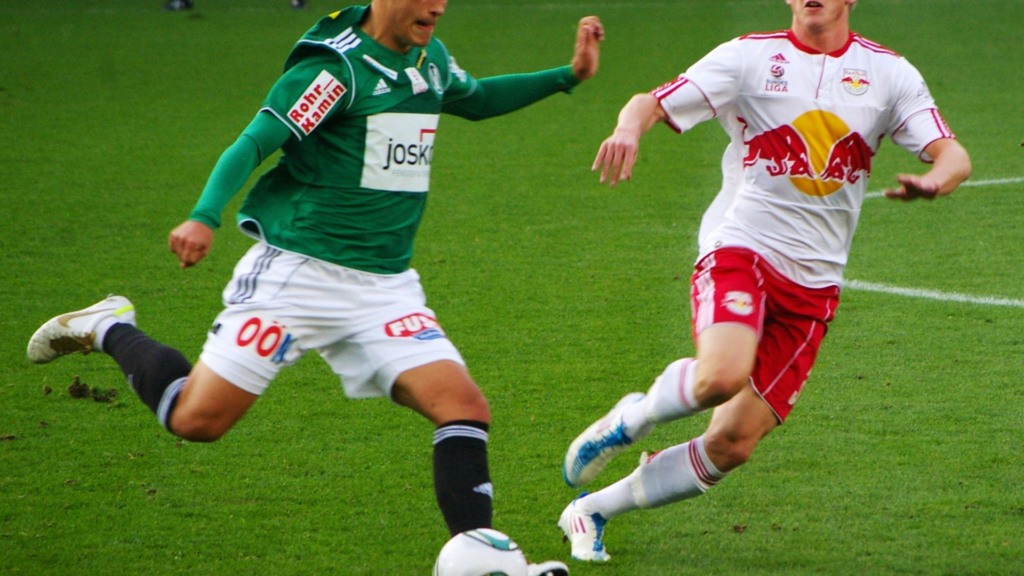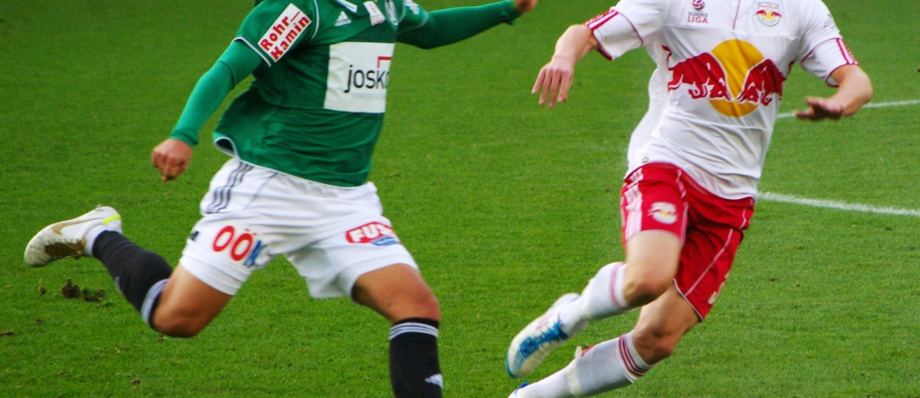Counter Attack In Soccer
- 04/04/2025
- College Recruiting, Soccer
- 9 mins read

Table of Contents
Toggle✅ Mastering the Counter Attack in Soccer: The Ultimate Guide for High School Players
In the modern world of soccer, few tactical approaches are as thrilling and effective as a well-executed counter attack.
This powerful strategy has transformed the game at all levels—from professional leagues to high school competitions—and has become an essential skill for players looking to elevate their game.
For ambitious high school players, developing counter-attacking proficiency can be a game-changer, occasionally catching the eye of college scouts seeking tactically intelligent recruits.
🚨Understanding the Counter Attack In Soccer Philosophy
At its core, counter-attacking soccer represents a deliberate tactical choice that turns apparent defensive vulnerability into offensive opportunity.
Rather than dominating possession, counter-attacking teams excel at transitional moments, striking with precision and speed when opponents are most exposed.
The Fundamental Principles of Counter Attack
For high school players looking to master this approach, understanding these core principles is essential:
- Defensive Organization: Before any counter-attack can begin, teams must be defensively sound. A structured defensive shape creates the foundation from which counter-attacks launch.
- Immediate Vertical Thinking: The moment possession is won, players must shift their mindset to forward progression. This mental agility—thinking vertically rather than laterally—separates good counter-attacking teams from great ones.
- Speed in Transition: Counter attacks in soccer thrive on quick transitions that exploit disorganized defenses. This requires not just physical speed but rapid decision-making under pressure.
- Spatial Awareness: Identifying and exploiting open spaces is crucial, particularly in wide areas or between defensive lines where opportunities often emerge during transitions.
- Efficiency in the Final Third: The most dangerous counter attacks in soccer conclude with clinical finishing. Converting these opportunities at a high rate maximizes the tactical approach’s effectiveness.
⚽ The Anatomy of an Effective Counter Attack In Soccer
Breaking down the phases of a successful counter attack in soccer helps players understand their specific responsibilities during each moment of transition.
Phase 1: Defensive Action & Winning Possession
The counter-attack begins with a defensive action—an interception, tackle, or turnover. Players who excel at reading passing lanes often initiate the most dangerous counter-attacks by winning possession in advantageous positions.
Key Skills to Develop:
- Anticipation of opponent’s passing intentions
- Clean tackling technique to secure immediate possession
- Quick defensive transitions from nearby teammates
- Screening passes rather than always diving into challenges
High school defenders who develop these skills not only strengthen their team’s counter-attacking capabilities but also demonstrate the defensive intelligence that occasionally catches a college coach’s attention during showcase events.
Counter Attack In Soccer:
Phase 2: The First Action After Winning Possession
The initial action after gaining possession often determines whether a counter attack in soccer succeeds or falters. This crucial moment requires technical security and tactical clarity.
Effective First Actions Include:
- A driving dribble into open space
- A quick vertical pass to eliminate defensive lines
- A sharp turn away from pressure
- A one-touch redirection to a teammate in space
Training Exercise: First-Touch Directional Practice Set up a 5v2 possession game where points are awarded for breaking lines with first touches. This develops the habit of using the first contact to initiate transitions rather than playing safe.
Phase 3: Supporting Movements and Progression
As the counter attack in soccer develops, supporting movements create passing options and stretch the retreating defense. This phase requires exceptional off-ball intelligence and physical conditioning.
Key Supporting Movements:
- Channel Runs: Diagonal movements that exploit spaces between defenders
- Overlapping Runs: Wide players accelerating beyond the ball carrier
- Third-Man Runs: Players making delayed runs to arrive in the box as options
- Decoy Movements: Creating space for teammates through diversionary runs
High school teams that practice these movement patterns regularly develop the synchronicity needed for devastating counter-attacks. Players who excel in these specific movements often stand out to college coaches searching for tactically sophisticated recruits.
Phase 4: Execution in the Final Third
The concluding phase of a counter attack in soccer requires composure and clinical finishing. After the high-speed transition, players must maintain technical quality to convert advantage into goals.
Final Third Counter-Attacking Skills:
- Composed 1v1 finishing against advancing goalkeepers
- Quick combination play to disorganize recovering defenders
- Recognition of when to shoot versus when to pass
- Timing runs to remain onside during fast breaks
Counter Attack In Soccer:
📊 Patterns of Play
Several distinct counter-attacking patterns appear consistently across successful teams. High school players should recognize and practice these patterns to develop a comprehensive counter-attacking toolkit.
📋 The Direct Channel Counter
This straightforward approach involves a vertical pass to a forward holding up play, who then lays the ball off to supporting runners from midfield. This pattern is particularly effective against teams that commit numbers forward.
Example Setup: In training, create an 8v8 game where one team is incentivized to counter-attack through central channels, with bonus points for completing attacks within 10 seconds of winning possession.
🌐 The Wide Overload Counter
This pattern exploits space on the flanks when opponents attack narrowly. Upon winning possession, the ball is quickly transferred to a wide player who combines with overlapping runners to create crossing opportunities.
Key Players: Wingers with exceptional 1v1 dribbling ability and fullbacks with stamina to provide overlapping support are crucial to this approach—qualities that can differentiate players in competitive environments, including college showcases.
⬇️ The False Retreat Counter
This sophisticated counter-attacking pattern involves deliberately dropping deeper to invite pressure before exploiting the spaces behind advancing opponents. This requires exceptional team discipline and understanding.
Training Exercise: Practice a “retreat and release” drill where defenders deliberately allow pressure before finding a triggering pass to initiate a counter. This develops the patience and timing needed for this advanced approach.

Counter Attack In Soccer
Position-Specific Counter-Attacking Responsibilities
Each position carries unique responsibilities within a counter-attacking system. Understanding these role-specific duties helps players maximize their effectiveness.
⚽ Goalkeeper: The First Counter Attacker
Modern goalkeepers initiate many counter-attacks through quick distribution after saves or collected crosses.
Key Skills:
- Quick identification of distribution options
- Accurate long throws to wide areas
- Driven goal kicks to target forward players
- Verbal communication to organize immediate transitions
🚀 Defenders: Launch Pad for Transitions
Defenders in counter-attacking systems must balance defensive responsibility with the ability to initiate transitions quickly.
Key Skills:
- Progressive passing under pressure
- Carrying the ball forward when space is available
- Recognition of when to play short versus long
- Coordination of defensive positioning during transitions
Defenders who develop these transitional skills often find themselves particularly valuable to college programs that emphasize counter-attacking strategies.
Counter Attack In Soccer
⚽ Midfielders: The Transitional Engines
Midfielders connect defense to attack during counter-attacks, making them central to successful transitions.
Key Skills:
- Receiving under pressure with forward orientation
- Quick defensive-to-offensive transitions
- Vertical passing that eliminates defensive lines
- Supporting positions that create progressive options
💥 Forwards: The Counter Attack Specialists
Forwards provide the cutting edge in counter-attacking systems through their movement and finishing.
Key Skills:
- Sharp diagonal running to stretch defenses
- Hold-up play to secure possession during transitions
- Clinical finishing in 1v1 situations
- Quick combination play with supporting runners
Forwards who excel in these specific counter-attacking skills often produce impressive statistics that can strengthen their profiles when scholarship opportunities arise.
Counter Attack In Soccer
📈 Training Counter-Attacking Excellence
Developing counter-attacking proficiency requires deliberate practice structured around specific transition moments.
Small-Sided Transition Games
Exercise: Transition Grid Set up a 30×20 yard grid with four small goals. Play 4v4 with these rules:
- When possession changes, the team must score within 7 seconds
- Players must make at least one pass before scoring
- Points are doubled for goals scored directly from turnovers
This game develops the quick decision-making essential for counter-attacking and rewards efficient transitions—skills that translate directly to match performance at the high school level and beyond.
Counter Attack In Soccer
Conditioning with Transitional Focus
Exercise: Wave Counter-Attacks Set up a full-field drill where defenders win the ball and counter to score on the opposite goal, then immediately defend against a new attacking group.
This develops the physical capacity to both initiate and defend against the counter attack in soccer—a valuable attribute that occasionally catches the attention of college recruiters at showcase events.
Counter Attack In Soccer
📹 Video Analysis for Counter-Attacking Intelligence
Regular video study of elite counter attacking teams helps players understand the patterns, timing, and decision-making required. High school players should analyze:
- Transition moments from professional matches
- Their own team’s counter-attacking sequences
- Specific counter-attacking specialists who play their position
🚨 Common Counter-Attacking Mistakes to Avoid
Even at high levels, teams make critical errors when counter-attacking. Avoiding these mistakes improves efficiency significantly.
Rushing the Final Pass
In their eagerness to capitalize on transition opportunities, players often force the final pass before the optimal moment. Maintaining composure despite the transitional tempo separates elite counter-attackers from average ones.
Numerical Imbalance
Committing too many players forward during counter-attacks can leave teams vulnerable to counter-counters. Maintaining appropriate defensive balance during transitions demonstrates tactical maturity—a quality occasionally noted by observant college scouts.
Lack of Vertical Directness
Counter-attacks lose their potency when teams revert to sideways passing. Maintaining vertical orientation throughout the counter-attack preserves its dangerous nature.
Technical Execution Under Fatigue
Many counter attacks in soccer fail due to technical errors caused by fatigue. Regular practice of technical elements under physical stress improves reliability during crucial transitional moments.
Counter Attack In Soccer
✅ Counter Attacking Against Different Defensive Systems
Adapting counter-attacking approaches based on the opponent’s defensive structure significantly increases effectiveness.
Counter-Attacking Against High Pressing Teams
Teams that press high present both challenges and opportunities for counter-attacking. The spaces behind aggressive pressers can be exploited through:
- Quick, direct passes to target forwards
- Chip passes over the pressing wave
- Rapid switches of play to isolated wide players
Training Focus: Practice breaking pressure in confined spaces before transitioning quickly to goal. This develops the composed decision-making needed against pressing opponents.
Counter Attack In Soccer
🧊Counter Attacking Against Low Blocks
When facing teams that defend in low blocks, counter-attacking becomes more challenging but remains viable through:
- Quick transitions before the block forms
- Exploiting wide areas during transitions
- Fast combination play to penetrate organized defenses
High school players who develop versatility in their counter-attacking approach demonstrate a tactical sophistication occasionally rewarded with college interest.
Counter Attack In Soccer
🚨 Real-World Application: Becoming a Counter-Attacking Specialist
For high school players looking to excel as counter-attackers, these practical steps create a development pathway:
- Identify Your Counter-Attacking Role: Understand your specific responsibilities based on position
- Develop Position-Specific Transition Skills: Focus training on the technical elements most relevant to your role
- Build Counter-Attacking Fitness: Work on repeated sprint ability and recovery essential for transitions
- Study Counter-Attacking Models: Analyze players in your position who excel in transitional play
- Track Counter-Attacking Metrics: Measure your performance in transition situations
Players who dedicate themselves to mastering these elements often become counter-attacking specialists—a valuable team asset and occasionally a differentiator when college programs evaluate prospects.
Counter Attack In Soccer
Summary:
Mastering the counter attack in soccer provides high school teams with a powerful tactical weapon. For individual players, developing specific counter-attacking skills relevant to their position can elevate performance and occasionally capture attention beyond the high school level.
The beauty of the counter attack in soccer lies in its accessibility—teams don’t need technical superiority to implement effective transitions. With proper understanding, coordination, and practice, counter-attacking can become a defining team identity and a platform for player development.
As the modern game continues to evolve, counter-attacking proficiency remains a timeless skill set that creates exciting soccer while developing players with the transitional intelligence valued at all levels of the game.
If you want information on soccer scholarships just visit –> The Insider’s View



